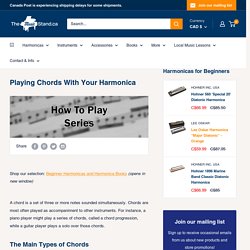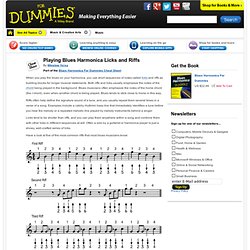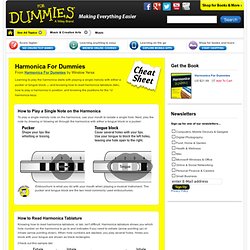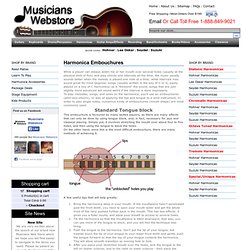

Facebook. Search. How to play harmonica (the blues) Harmonica Lessons - Learn To Play Blues Harmonica. Bending Notes with the Harmonica. If you play the main blow and draw notes available on a diatonic harmonica, you’ll be able to sound seven different notes (or 19 different pitches, if you count the notes that repeat).

The complete chromatic scale contains 12 different notes, which means that the standard diatonic harmonica is “missing” five notes. A special technique called bending makes it possible to play some of the missing notes of the chromatic scale on any ordinary diatonic harmonica. The physics behind blow bends and draw bends is rather complex. The quick explanation for how bends can possibly produce notes that “don’t exist” on the harmonica is this:By altering the flow of air through the blow reeds and draw reeds at certain holes, you can make both reeds vibrate at once, which in turn allows the “missing” notes to sound.
The C Harmonica’s Five Missing Notes Half Steps and Whole Steps The notes that make up musical scales are all either one half step or one whole step apart. Draw Bends How to Play Draw Bends. Notes of a "C" key Harmonica. Most diatonic harmonicas contain 10 holes, each of which can produce two notes through ordinary blowing or drawing.

The holes are referred to primarily by number (1–10), rather than by the notes they produce. Playing Chords with the Harmonica. Shop our selection: Beginner Harmonicas and Harmonica Books (opens in new window) A chord is a set of three or more notes sounded simultaneously.

Chords are most often played as accompaniment to other instruments. For instance, a piano player might play a series of chords, called a chord progression, while a guitar player plays a solo over those chords. The Main Types of Chords Chords come in a wide variety of types based on the specific notes they contain. Major chords: Sound bright and pleasantMinor chords: Sound dark and menacingSeventh chords: Sound unresolved and somewhat dissonant—neither bright nor dark. 1000 Harmonica tabs. Harmonica country.
Wildflower Harmonica Instruction. Playing Blues Harmonica Licks and Riffs. When you play the blues on your harmonica, you use short sequences of notes called licks and riffs as building blocks for longer musical statements.

Both riffs and licks usually emphasize the notes of the chord being played in the background. Blues musicians often emphasize the notes of the home chord (the I chord), even when another chord is being played. Blues tends to stick close to home in this way. Riffs often help define the signature sound of a tune, and you usually repeat them several times in a verse of a song.
Examples include a catchy rhythmic bass line that immediately identifies a tune before you hear the melody or a repeated melodic line played by melody instruments behind a singer. Licks tend to be shorter than riffs, and you can play them anywhere within a song and combine them with other licks in different sequences at will. Have a look at five of the most common riffs that most blues musicians know: Guitars Glossary 12/8 groove 12-bar blues 7th chord accent accidentals attack. Harmonica For Dummies Cheat Sheet. Cheat Sheet Learning to play the harmonica starts with playing a single melody with either a pucker or tongue block — and knowing how to read harmonica tablature (tab), how to play a harmonica in position, and knowing the positions for the 12 harmonica keys.

Harmonica Definitions. While a player can always widen his or her mouth over several holes (usually at the physical limit of five) and play chords and intervals all the time, the music usually sounds better when the melody is played one note at a time; while intervals may sound great for most beginner songs (usually written in the key of C or G, easily played on a key of C harmonica) as it "thickens" the sound, songs that are just slightly more advanced will sound weird if the interval is done improperly.

To play melodies, songs, and solos on the harmonica, you’ll use an embouchures (ahm-boo-shoors), or way of applying the lips and tongue to a wind instrument. In order to play single notes, numerous kinds of embouchures (mouth shape) are most commonly used: